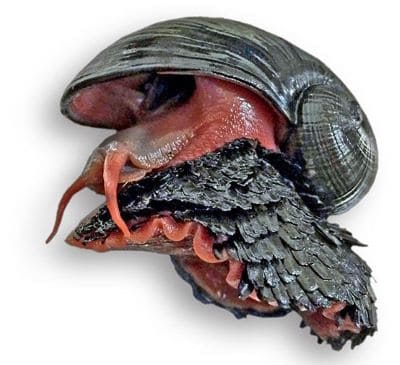Home › Sea Life › Marine › Invertebrate › Mollusks › Snails › Scaly-foot Gastropod
Interesting Facts about the Scaly-Foot Snail
[Phylum: Mollusca] [Class: Gastropoda] [Order: Neomphalida] [Family: Peltospiridae]
Because the shell of this marine gastropod mollusc is actually made of iron, it's true to say that the scaly-foot snail is magnetic.
This guide contains fun facts about scaly-foot gastropods (Chrysomallon squamiferum), including where they live, what they eat, and how these deep-sea hydrothermal-vent snails reproduce.
Habitat and Distribution of C. Squamiferum
Chrysomallon squamiferum is the scientific name given to this "metal mollusc". But, other common names include:
- Sea pangolin
- Scaly-foot snail (scaly-foot gastropod)
- Volcano snail
You'd need to visit one of three hydrothermal vent fields that run along deep sea ridges in the Indian Ocean to see the scaly-foot snail living in its natural habitat.
Life in this remote and specialist environment, at depths approaching 2,900 metres (1.8 miles), is the main reason why scaly-foot gastropods have a severely fragmented population and limited geographical range.
As a consequence, they thrive best in water temperatures around 5° Celsius (41° Fahrenheit) and they can survive in areas with low oxygen and high concentrations of hydrogen sulphide (a colourless chalcogen-hydride gas).
Pro Tip: The sea snail segment explains more about the vital role of marine gastropod snails in saltwater seas and oceans around the world.
Metal Mollusc Characteristics and Behaviour
The three layered construction of the scaly-foot snail shell is unique for several reasons. The outer layer contains a chemical compound that incorporates both iron and sulphur (e.g. iron sulphides).
Like most shelled gastropods, the middle layer of the shell shares similarities with the organic periostracum. But, the innermost layer is made of a carbonate mineral called aragonite.
 They are not a large species and the scaly-foot gastropod measures about three (3) centimetres long. But, its oversize heart accounts for almost 4% of its body volume.
They are not a large species and the scaly-foot gastropod measures about three (3) centimetres long. But, its oversize heart accounts for almost 4% of its body volume.
These remarkable examples of sea invertebrates use a large, muscular, scaly foot (squamous) to propel their body.
It comes into view as it extends forward out of the shell and pushes the snail along the ocean floor.
The ventral foot contains an "armour-like" construction with iron-mineralised sclerites layered down the sides.
What Do Scaly Foot Gastropods Eat?
Scientists believe the volcano snail gets its nourishment via symbiotic gammaproteobacteria housed inside the digestive system.
In other words, it's not a filter-feeder and it doesn't use any other typical feeding mechanisms. Even so, the scaly-foot gastropod does obtain nutrition from the oxidation of electron donors (chemoautotrophy of its endosymbiotic bacteria).
Fun Fact: Marine prosobranch gastropods transfer organic material towards the edge of their gills. They consume it as a source of food through a process called deposit feeding or suspension.
Iron Snail Reproductive Process
Being a simultaneous hermaphrodite means each individual has both male and female sex organs. As a result, it also has a high fertility rate (fecundity) and an ability to produce a superabundance of offspring.
Scaly-foot snail eggs are negatively buoyant (they don't float in water) under atmospheric pressure. Thus, despite limited research of larvae and juveniles, some shell lengths of newborns can measure only two (2) millimetres.
Threats and Predators
Despite living in the adverse environment of oceanic hydrothermal vents, or because of it, the scaly-foot gastropod is not a protected species.
Moreover, energy production and deep sea mining both contribute to the continuing decline of mature individuals, posing a significant threat to their long term survival. Even so, natural predators of scaly-foot snails include crabs and some species of venomous snails.
Important: Some of the world's biggest sea snails (e.g. the horse conch) are at risk of extinction. Furthermore, the World Conservation Organization (IUCN) updated the scaly-foot snail (found in the Indian Ocean) to the Red List of Endangered Species in July 2019.
Related Information and Help Guides
- Australian Trumpet Shell Facts and Information
- Fun and Interesting Facts about Cone Snails
- Slipper Shell Snail Characteristics and Behaviour
- Sea Butterfly Habitat and Reproduction
- Nudibranchia: Sea Slug Phylum and Classification
- Types of Sea Snails and Species Information
Note: The short video [2:09 seconds] presented by "Deep Marine Scenes" contains some amazing footage and interesting facts about the deep sea armoured snail (Chrysomallon squamiferum).